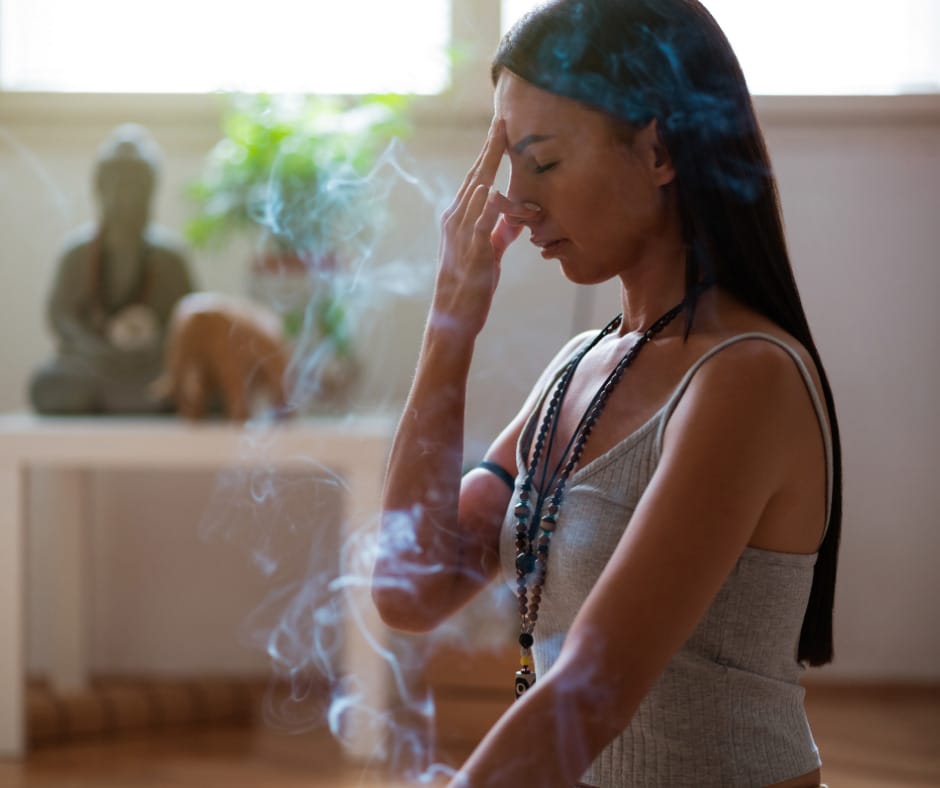
Yoga Therapy addresses the whole being of your body’s needs, life energy, emotions, thoughts, and spirit of the higher self. We already possess everything we need inside of us but might need help accessing these parts of ourselves on the spiritual level. Yoga Therapy views the human experience as made up of Five Koshas, or layers, from the physical body to the highest self. This is called the Panchamaya Kosha System. With the Panchamaya Kosha System in mind, we can work with a multilayer approach to wellness by addressing these layers. Below we’ll dive into the Kosha System but learn more about what Yoga Therapy is by visiting other articles online or through one of our online Yoga Therapy courses.
The Pranamaya Kosha is the second layer of the Panchamaya Kosha System. It is considered the life energy layer. Prana means energy or life-force and is the vital energy that flows through the body. It is greatly influenced by pranayama. This layer is also thought of as the “breath layer.” It’s more subtle than the physical body layer as we cannot see the breath but we can feel it moving. From a yoga therapy perspective, the pranamaya (breath layer) is between the physical body and the layer of the mind, therefore, it serves as a bridge between the two.
Breath is the only associated physiological response of the nervous system that can be brought under our conscious control. Just bringing awareness to the breath can slow it down and smooth it out. When we’re stressed, our breathing can become fast and shallow. This is a symptom of the stress response and a signal to the body that something is not correct. Rapid, shallow breathing can activate the sympathetic nervous system (SNS), which controls your fight, flight, freeze, and fold response. Breathing exercises called pranayama, and kriyas communicate very effectively with the body. They are critical during times of high stress. Slow, deep breathing can activate its counterpart, the parasympathetic nervous system (PNS), which controls your rest and digest response. Anatomy teacher Leslie Kaminoff says, “The goal of breath training is to free up the system from habitual, dysfunctional restrictions–and the first thing we need to free the breath from the idea that there’s a single right way to do it.”
Here are three breathing exercises that are easily accessible in stressful situations like a traffic jam, a dental appointment, or anything that might make you feel activated or experience big emotions.
The three-part breath or full yogic breath can help you breathe fully and completely.
- On the inhalation, the breath descends down the throat to a point low in the chest on the inhale. The belly should be relaxed and subtly expand with the breath. The side ribs will expand as the chest rises.
- Each part of the breath flows smoothly into the other.
- On the exhale, the breath is released slowly and naturally.
This breath practice can help bring awareness to dysfunctional breathing patterns, activates the PNS, promotes relaxation, reduces stress, increase lung capacity, and promotes a sense of wellness.
According to Desikachar and the Krishnamacharya tradition, the essential part of the breath is exhalation. T.K.V. Desikachar said in his book The Heart of Yoga, “If the quality of the exhalation is not good, the quality of the whole pranayama practice is adversely affected. When someone is not able to breath out slowly and quietly, it means that they are not ready for pranayama.”
Using sound to lengthen the exhalation is accessible for most people. If the exhale is shorter than the inhale, use the exhale techniques to lengthen this part of the breath gradually. Inhale and exhale the sound. Starting with a sound that’s comfortable for you. Examples are Shhhh, Ahhhhh, Maaaaa, and humming. Singing with the radio is also another option. Explore what sounds resonate with you and bring awareness to shifts in the emotional and energetic bodies.
Finger Nyasa or Five Finger Breathing – it may be hard to focus on the breath when you are in heightened anxiety, so finger breathing can help focus the mind. You watch and feel your fingers at the same time you are paying attention to your breath. This will help focus on staying calm instead of letting your mind and thoughts wander.
To start:
- Place the index finger of one hand at the base of the pinky finger of your opposite hand.
- Breathe in a while, tracing your index finger up to the tip of your pinky, and breathe out while you trace back down.
- Move on to your ring finger.
- Breathe in while moving up and breathe out while moving back down.
- Continue until you’ve outlined your entire hand.
- Reverse and move back toward your pinky.
Slow and controlled breathing exercises have been found to help the body achieve a state of calm. Reaching this state is associated with better sleep, improved mood, less or reduced risk of anxiety, autoimmune diseases, hypertension, and heart-related diseases.
Remember, your breath is your anchor.
If you are interested in becoming a certified Yoga Therapist, check out My Vinyasa Practice’s IAYT accredited program, available fully online and remote for anyone enrolling before 2024.
